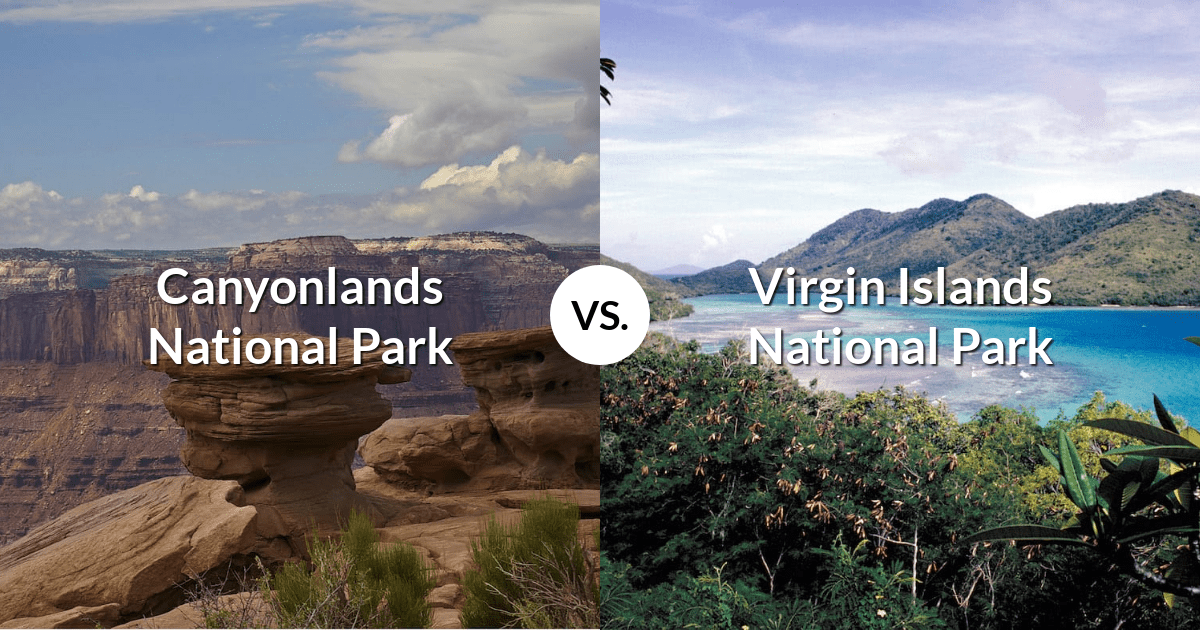Jake Cain is an entrepreneur and writer from Cincinnati, Ohio. He spends his free time driving around the country in his late 90’s conversion van, affectionately known as the “Monster Van” with his wife and 3 boys.
Get ready for an adventure of a lifetime as we take you on a journey to compare two of the most breathtaking national parks in the United States – Canyonlands National Park and Virgin Islands National Park. On one hand, you have Canyonlands with its towering mesas, deep canyons, and striking rock formations that will take your breath away. On the other hand, you have Virgin Islands, with its turquoise waters, pristine beaches, and lush tropical forests that will transport you to a world of pure paradise. Both parks offer unique landscapes and experiences, but which one will win your heart? Will it be the rugged beauty of Canyonlands or the tropical bliss of Virgin Islands? Join us as we explore the similarities and differences between these two stunning parks and discover which one is the perfect fit for your next adventure.
Hiking Trails in Canyonlands National Park and Virgin Islands National Park
Canyonlands National Park and Virgin Islands National Park both offer a diverse range of hiking trails for visitors to explore. However, the type of hiking experiences offered at each park are quite different.
At Canyonlands National Park, hikers can expect to tackle challenging trails with steep inclines and rough terrain. Some of the most difficult hikes include the Chesler Park Loop, which is a 11-mile trail with steep climbs and rocky terrain, and the Druid Arch Trail, which is a strenuous 8-mile hike that takes you to the base of a towering natural arch. For those looking for a less strenuous hike, the Island in the Sky district offers several easy trails, such as the Mesa Arch Trail, which is a short 0.5-mile hike to a stunning natural arch, and the Grand View Point Trail, which is a 1.5-mile hike with breathtaking views of the surrounding canyons.
At Virgin Islands National Park, the hiking trails are generally easier and offer a more leisurely experience. Some of the easiest hikes include the Cinnamon Bay Nature Trail, which is a 0.5-mile trail through a lush tropical forest, and the Maho Bay Nature Trail, which is a 1-mile trail with views of Maho Bay and the surrounding hills. For those looking for a more challenging hike, the Reef Bay Trail is a strenuous 3.5-mile hike that takes you through the rainforest and down to the beach.
In conclusion, both Canyonlands National Park and Virgin Islands National Park offer a variety of hiking experiences, ranging from easy to challenging. Whether you are looking for a leisurely stroll or a strenuous hike, both parks have something to offer.
Most Popular Hiking Trails in Canyonlands National Park
| Name | Length | Elevation | Type | Difficulty | Visitor Ratings |
|---|---|---|---|---|---|
| Mesa Arch Trail | 965.604 | 18.8976 | Easy | loop | 4.5 |
| Grand View Point Trail | 2896.812 | 52.7304 | Easy | out and back | 4.5 |
| Chesler Park Loop Trail | 18668.344 | 589.788 | Moderate | loop | 5 |
| False Kiva Trail | 3057.746 | 136.8552 | Moderate | out and back | 4.5 |
| Upheaval Dome via Crater View Trail | 2414.01 | 91.7448 | Moderate | out and back | 4 |
| Aztec Butte Trail | 2092.142 | 66.7512 | Moderate | out and back | 4.5 |
| Druid Arch Trail | 15288.73 | 418.7952 | Moderate | out and back | 4.5 |
| Shafer Trail | 30899.328 | 949.7568 | Moderate | point to point | 4.5 |
| White Rim Overlook Trail | 2896.812 | 48.768 | Easy | out and back | 4.5 |
| Syncline Loop | 13840.324 | 496.824 | Very Hard | loop | 4.5 |
Most Popular Hiking Trails in Virgin Islands National Park
| Name | Length | Elevation | Type | Difficulty | Visitor Ratings |
|---|---|---|---|---|---|
| Wind Canyon Trail | 804.67 | 16.764 | Easy | loop | 4.5 |
| Caprock Coulee Loop | 6115.492 | 159.7152 | Moderate | loop | 4.5 |
| Painted Canyon Nature Trail | 1770.274 | 78.9432 | Easy | loop | 4 |
| Petrified Forest Trail | 16415.268 | 253.8984 | Moderate | loop | 4 |
| Maah Daah Hey Trail | 229009.082 | 4614.9768 | Hard | point to point | 4.5 |
| Lower Paddock Creek Trail | 11587.248 | 127.7112 | Moderate | out and back | 4.5 |
| Buck Hill Trail | 643.736 | 16.764 | Moderate | out and back | 4.5 |
| Ridgeline Nature Trail | 1126.538 | 33.8328 | Moderate | out and back | 4 |
| Coal Vein Trail | 965.604 | 4.8768 | Easy | loop | 4 |
| Buckhorn Trail | 19633.948 | 324.9168 | Hard | loop | 4.6 |
Wildlife in Canyonlands National Park and Virgin Islands National Park
Canyonlands National Park and Virgin Islands National Park are two distinct national parks with different geographies, climates, and ecosystems. As a result, the wildlife found in each park is unique.
Canyonlands National Park, located in southeastern Utah, is known for its rugged desert landscape and diverse wildlife. Common animals seen in the park include desert bighorn sheep, coyotes, pronghorns, and various species of lizards and snakes. Birdwatchers can expect to see a variety of birds, including hawks, eagles, and vultures, as well as a number of migratory species that stop in the park during their annual journeys. In terms of plants, the park is home to a variety of cacti, shrubs, and wildflowers, including the iconic Joshua tree.
Virgin Islands National Park, located on the island of St. John in the U.S. Virgin Islands, is a tropical paradise with lush forests and pristine beaches. The park is home to a diverse array of wildlife, including many species of birds, such as the bananaquit and the green-throated Carib, as well as reptiles, such as iguanas and geckos. Visitors may also spot various species of mammals, including the endangered Virgin Islands tree boa and the West Indian manatee. The park is also known for its diverse plant life, including tropical hardwoods, mangroves, and lush tropical vegetation.
In conclusion, both Canyonlands National Park and Virgin Islands National Park offer unique and diverse wildlife experiences, but the types of animals, birds, and plants seen in each park are quite different due to the distinct geographies and climates of the two parks.
Below are lists of the most commonly spotted wildlife at Canyonlands National Park and Virgin Islands National Park. However, you can see a full list of wildlife at each national park here.
Birds
| Canyonlands National Park | Virgin Islands National Park |
|---|---|
| Peregrine Falcon | Peregrine Falcon |
| Northern Harrier | Northern Harrier |
| Sharp-Shinned Hawk | Sharp-Shinned Hawk |
| Osprey | Osprey |
| Tree Swallow | Tree Swallow |
| Mallard | Mallard |
| Canada Goose | Canada Goose |
| Lincoln’s Sparrow | Lincoln’s Sparrow |
| Ruby-Crowned Kinglet | Ruby-Crowned Kinglet |
| American Robin | American Robin |
| Great Horned Owl | Great Horned Owl |
| Red-Tailed Hawk | Red-Tailed Hawk |
| Northern Flicker | Northern Flicker |
| Merlin | Merlin |
| Barn Swallow | Barn Swallow |
| Savannah Sparrow | Savannah Sparrow |
| Great Blue Heron | Great Blue Heron |
| Hermit Thrush | American Kestrel |
| American Kestrel | Bald Eagle |
| Bald Eagle | Song Sparrow |
| Song Sparrow | European Starling |
| European Starling | Northern Pintail |
| Northern Pintail | American Wigeon |
| American Wigeon | Green-Winged Teal |
| Green-Winged Teal | Swainson’s Thrush |
Mammals
| Canyonlands National Park | Virgin Islands National Park |
|---|---|
| Coyote | Coyote |
| American Beaver | American Beaver |
| Muskrat | Muskrat |
| Big Brown Bat | Big Brown Bat |
| Bobcat | Bobcat |
| Striped Skunk | Striped Skunk |
| Little Brown Bat | Little Brown Bat |
| Deer Mouse | Deer Mouse |
| Raccoon | Raccoon |
| Black Bear | Porcupine |
| Porcupine | Silver-Haired Bat |
| Silver-Haired Bat | Hoary Bat |
| Hoary Bat | Red Fox |
| Red Fox | Long-Tailed Weasel |
| Long-Tailed Weasel | House Mouse |
| House Mouse | Mountain Lion |
| Mountain Lion | Mink |
| American Mink | Mule Deer |
| Mule Deer | Gray Wolf |
| Common Gray Fox | Long-Legged Myotis |
| Long-Legged Myotis | Long-Eared Myotis |
| Long-Eared Myotis | Badger |
| American Badger | Snowshoe Hare |
| Ermine | North American River Otter |
| California Myotis | Masked Shrew |
Fish
| Canyonlands National Park | Virgin Islands National Park |
|---|---|
| Rainbow Trout | Longnose Sucker |
| Brown Trout | Green Sunfish |
| Largemouth Bass | Bluegill |
| Green Sunfish | Flathead Minnow |
| Bluegill | Golden Shiner |
| Fathead Minnow | Carp/European Carp |
| Common Carp | Northern Pike |
| Northern Pike | Burbot |
| Speckled Dace | Longnose Dace |
| Yellow Bullhead | Channel Catfish |
| Channel Catfish | Black Bullhead |
| Kokanee Salmon | Creek Chub |
| Black Crappie | |
| Black Bullhead | |
| Mosquitofish | |
| Smallmouth Bass |
Reptiles
| Canyonlands National Park | Virgin Islands National Park |
|---|---|
| Gophersnake | Bullsnake |
| Terrestrial Gartersnake | Racer |
| Eastern Racer | Rattlesnake |
| Prairie Rattlesnake | Sagebrush Lizard |
| Common Sagebrush Lizard | Common Garter Snake |
| Greater Short-Horned Lizard | Hernandez’s Short-Horned Lizard |
| Side-Blotched Lizard | |
| Common Kingsnake | |
| Nightsnake | |
| Long-Nosed Leopard Lizard | |
| Striped Whipsnake | |
| Smith’s Black-Headed Snake | |
| Tree Lizard | |
| Western Whiptail | |
| Eastern Collared Lizard | |
| Desert Spiny Lizard |
Amphibians
| Canyonlands National Park | Virgin Islands National Park |
|---|---|
| Northern Leopard Frog | Northern Leopard Frog |
| Tiger Salamander | Tiger Salamander |
| American Bullfrog | Woodhouse’s Toad |
| Woodhouse’s Toad | Plains Spadefoot |
| Red-Spotted Toad | |
| Canyon Treefrog |
Beautiful Landscapes in Canyonlands National Park and Virgin Islands National Park
Canyonlands National Park, Utah:
– The Island in the Sky: a vast plateau with panoramic views of the surrounding canyons and mesas.
– The Needles: a series of towering rock spires and multi-colored sandstone formations.
– The Maze: a labyrinth of canyons and rock formations, known for its remote and rugged wilderness.
– Green River Overlook: offers a stunning view of the Green River and the surrounding canyon landscape.
Virgin Islands National Park, US Virgin Islands:
– Trunk Bay: a clear blue-water beach with a famous underwater snorkeling trail.
– Cinnamon Bay: a stunning white-sand beach surrounded by lush green vegetation.
– Reef Bay Trail: leads to a waterfall and petroglyphs, showcasing the island’s natural beauty and cultural history.
– Ram Head Trail: offers breathtaking views of the Caribbean Sea and the surrounding hills.
Things To-Do and Activities in Canyonlands National Park and Virgin Islands National Park
Canyonlands National Park and Virgin Islands National Park are two very different national parks that offer a range of activities for visitors to enjoy.
Canyonlands National Park, located in southeastern Utah, is known for its rugged desert landscape and offers a range of outdoor activities for visitors to enjoy. Some of the most popular activities in the park include hiking, backpacking, and camping, as well as off-road driving and mountain biking. Visitors can explore the park’s many canyons, mesas, and buttes, as well as its scenic overlooks and scenic drives. The park is also popular for its rock climbing, river rafting, and kayaking opportunities.
Virgin Islands National Park, located on the island of St. John in the U.S. Virgin Islands, is a tropical paradise that offers a range of water-based activities for visitors to enjoy. Some of the most popular activities in the park include snorkeling, scuba diving, and kayaking, as well as beachcombing and sunbathing. Visitors can explore the park’s many pristine beaches and coves, as well as its lush tropical forests and scenic hiking trails. The park is also popular for its sailing and windsurfing opportunities, as well as its fishing and boating excursions.
In conclusion, both Canyonlands National Park and Virgin Islands National Park offer a range of activities for visitors to enjoy, but the types of activities available in each park are quite different due to the distinct geographies and climates of the two parks. Whether you prefer rugged outdoor adventures or tropical water-based activities, both parks offer something for everyone.
Best Time to Visit Canyonlands National Park and Virgin Islands National Park
Canyonlands National Park and Virgin Islands National Park have vastly different climates, which affects the best time to visit each park.
Canyonlands National Park, located in Utah, has a desert climate with hot summers and cold winters. Summer temperatures can reach over 100°F while winter temperatures can drop below freezing. The park is best visited in spring (March to May) or fall (September to November) when temperatures are more moderate.
Virgin Islands National Park, located in the U.S. Virgin Islands, has a tropical climate with warm temperatures year-round. Average temperatures range from the mid-70s to low 80s°F. The park is best visited from December to April, when the weather is dry and the risk of hurricanes is low.
In conclusion, the weather at Canyonlands National Park and Virgin Islands National Park is vastly different, with Canyonlands experiencing hot summers and cold winters, and Virgin Islands having warm temperatures year-round. The best time to visit each park is during the spring and fall for Canyonlands, and December to April for Virgin Islands, when the weather is more favorable.
Family Friendliness of Canyonlands National Park and Virgin Islands National Park
Canyonlands National Park and Virgin Islands National Park are both great parks to visit, but they each offer different experiences that may be more or less suitable for families traveling with children.
Canyonlands National Park, located in southeastern Utah, offers a range of outdoor activities that can be enjoyed by families with children. The park is known for its scenic drives, hiking trails, and picnic areas, as well as its educational programs and ranger-led activities. Children can explore the park’s unique desert landscape and learn about the plants and animals that live there. However, the park’s rugged terrain and remote location may make it less suitable for families with very young children or those who prefer a more relaxed and leisurely pace.
Virgin Islands National Park, located on the island of St. John in the U.S. Virgin Islands, is a tropical paradise that offers a range of water-based activities for families with children. The park’s many pristine beaches and coves are perfect for swimming, snorkeling, and sunbathing. The park also offers ranger-led activities and educational programs, as well as picnic areas and scenic hiking trails. Children can explore the park’s lush tropical forests and learn about the plants and animals that live there. The park’s relaxed and leisurely pace, combined with its tropical climate and beautiful scenery, make it a great destination for families with children.
In conclusion, both Canyonlands National Park and Virgin Islands National Park offer unique and enjoyable experiences for families with children, but the park that is best for your family will depend on your individual preferences and travel style. If you prefer rugged outdoor adventures and scenic drives, Canyonlands National Park may be the better choice. If you prefer tropical water-based activities and a relaxed pace, Virgin Islands National Park may be the better choice.


